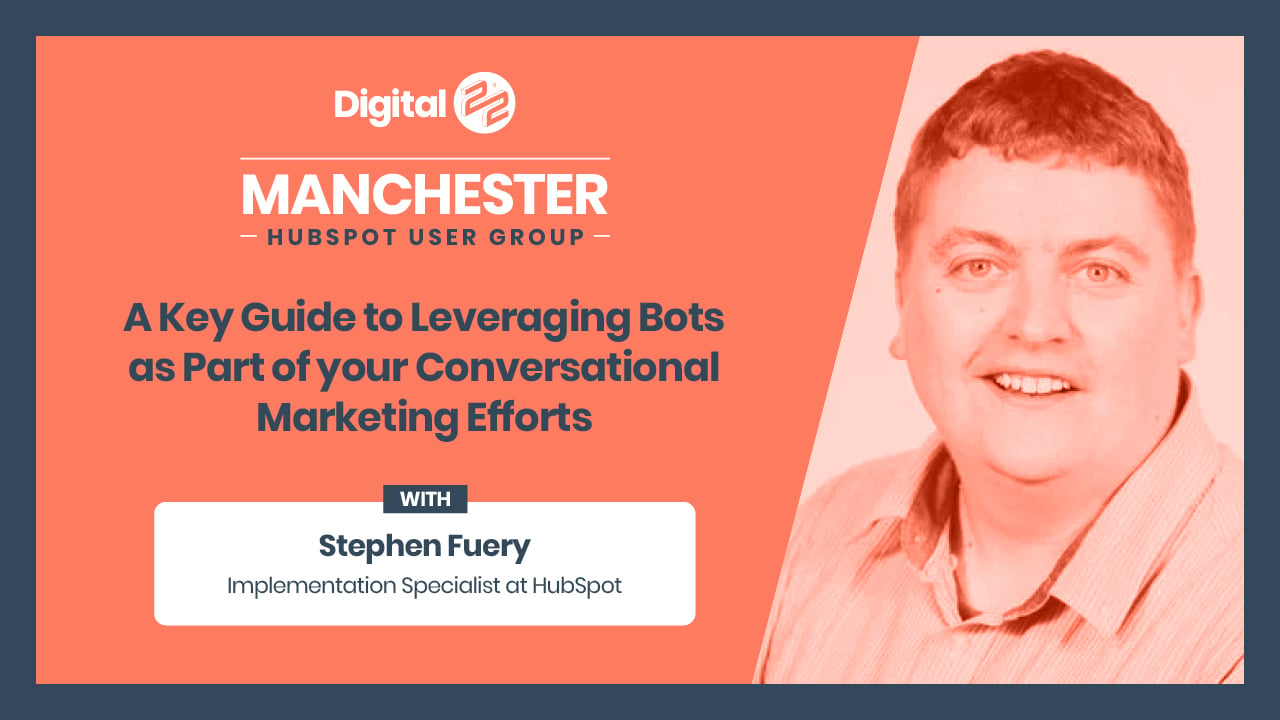Artificial Intelligence (AI) is growing in popularity pretty much everywhere you see. In fact, even...
Artificial Intelligence is (kind of) taking over the world. Robots might not be revolting in an AI takeover with Will Smith as our only hope, but bots are the future, and you’re probably wondering whether or not your business needs to create or use a bot in your marketing efforts. To clear up the confusion and misconception of bots, HubSpot’s implementation specialist, Stephen Fuery delivered a talk on bots during the Manchester HUG event in August.
Check out the video below to watch Stephen’s talk on bots, or continue reading to see what was covered.
Bots are a relatively new area for HubSpot themselves, so it’s not something you’re immediately going to be an expert in. Luckily for you, HubSpot has made it almost too easy to get started.

Why bots are needed
You might have the greatest sales team possible and an even better support team, so you probably think that you don’t even need to implement bots. While that might be the case, imagine how beneficial bots could be when there’s nobody in your office to respond to visitors.
Bots can help automate a wide range of customer-facing conversations for businesses. This improves efficiency and most importantly, it maximises user satisfaction as you’re able to build and implement an experience that’s entirely conversational in nature, right inside of apps that your visitors or qualified leads are already using.
So, bots can help instantly solve problems whenever they need it, rather than waiting until the next day for the support team to respond.
Why aren’t (some) businesses using bots right now?
Like any ‘new’ piece of technology, it’s going to take time to get more and more businesses and users on board. However, Stephen highlighted that there are some common reasons he and the other bot specialists at HubSpot come across more often than not - along with simple solutions.
- Lack of technical resources, especially if a bot needs to be built from scratch.
Solution: It doesn’t need to be difficult, in all honesty. You’re able to use a graphical interface, just like what you use to build your landing pages and email workflows, for example. There’s nothing too challenging to learn.
- There might be some difficulty connecting bots with relevant data and integration might not be straightforward.
Solution: Bots is part of the HubSpot ecosystem. This means that it’s pretty easy to connect it to other tools and plug it into components like Salesforce or any other CRM choice. Plus, there's no coding.
- Intimidated by futuristic technology.
Solution: You can’t blame businesses for being ‘afraid’ of moving to an online world 24/7 because potential customers will be interacting with your business even when you’re asleep. However, think about it this way: With bots, you’re always speaking to your best and most qualified leads, rather than waiting around and bots can only say things that you allow them to.
- Unsure of what exactly makes a good bot.
Solution: This is another one which is easy to solve, primarily because ‘what makes a good bot’ is subjective. It all depends on what the bot is supposed to be doing for YOUR business. There aren’t any guidelines, so if it’s solving something for your customers, then it’s a great bot because it’s doing its job.
- There are just too many bots out there so it’s hard to choose.
Solution: With there being so many bots out there, businesses might decide not to choose one at all because it seems such a big task. However, HubSpot has tried to make it as simple as possible.
The implementation of bots
While there aren’t any solid guidelines to follow because it depends on your own circumstances, there are some things you need to take into consideration when your business begins to implement bots.
- In all cases, bots should be easy to both create and use - without prior bot knowledge.
- Bots should be able to solve real problems and make it easy to measure success.
- Your bots should offer first-class integrations across sales, marketing and service systems.
- The bots should also support complexity when desired to make sure you satisfy visitors.
Conversational marketing
In simple terms, conversational marketing is the process of having real-time one to one conversations to capture, qualify and engage with your best leads. So, conversational marketing is pivotal when it comes to creating and implementing bots. Some rather frightening stats to take into consideration include:
- 42% of people in the UK are willing to answer a phone call from an anonymous phone call or from a number they don’t recognise.
- 2% of people in the UK refers to the average conversion rate on a form, landing page or gated content.
- 20% is the median open rate of emails in the UK.
As you can tell, it shows that marketers are getting through to fewer people. It’s not all doom and gloom, though.
Bots can be used to supplement your efforts even more. You can move to a point where you don’t need to rely on filled-out forms. Instead, your leads can interact with a bot; bots can recognise them as their contact record is in the HubSpot CRM so they’d get personalised greetings along with a selection of choices.
You’re able to give your content offer right in the chat window and they don’t need to navigate to find it - everyone’s a winner.
The inbound messaging framework
The Inbound Messaging Framework is an additional element on top of the existing inbound framework in marketing and sales.

As you’ll be able to see above, it works as a circle where each section needs to be taken into account when creating and implementing bots.
This includes being available to solve problems, continuing to optimise the conversational strategy, delivering solutions and understanding the user’s intent in an efficient way.
Building your own bot
One of the best things about getting starting is that you’re not starting from scratch with HubSpot. Thankfully, they’ve already done the tricky bit - we just need to pick the bot which suits our needs the best.
Bots range from support bots which allow users to gain some knowledge and can create tickets. Qualify leads is a bot which can find out if a visitor is qualified enough before sending the visitor to a sales rep as well as a meeting bot, which pretty much does what it says on the tin - arranges meetings.
Stephen also highlighted the use of Bot Editor - which looks like the familiar tool used to create workflows - as well as the fact that it’s also fully integrated with the new Conversations tool.
Not only that, but click on the video above to see Stephen discuss Junior, the bot he created on the HubSpot system and all of the features it possesses (it took just 30 minutes of building, by the way).
To read about all of the different types of bots available, what each one does and how it can help, check out what HubSpot currently has on offer.
Bots are the future of brand communication and the numbers live up to the hype.
Today, messaging apps have over five billion monthly active users. On Facebook Messenger alone there are over 100,000 bots and that doesn’t include the bots on platforms like Slack and WeChat, for example.
Join us at the next Manchester HUG
Stephen is just one of the many experts that deliver talks at the Manchester HUG event. If you like the look of the Manchester HubSpot User Group, join us at the next one.
At the October 2018 event, HubSpot’s Dan Tyre will be giving a full product rundown following INBOUND 2018, so book your tickets today.



